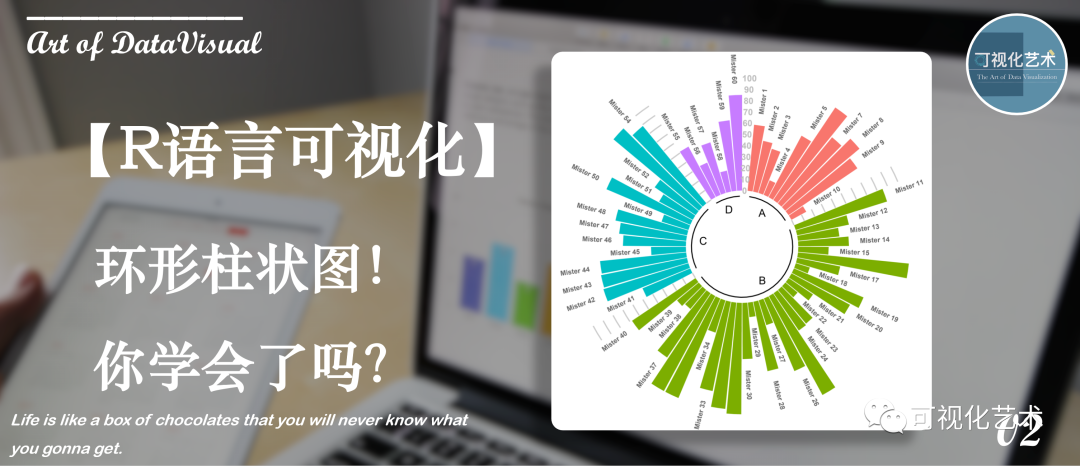
上一节师兄给大家介绍了在R语言中,常用的柱状图绘图技巧!如柱状图分组、调色、堆积柱状图、柱状图加误差棒等等!这一小节师兄准备带大家「玩点有意思的」!把「柱状图画成环状的」!别看成了饼图哦!它们还是柱状图哦!
❝本期「代码+示例数据+效果图+课程笔记」,均可在公众号「可视化艺术」后台回复「20220228」获得!
❞
本期效果展示

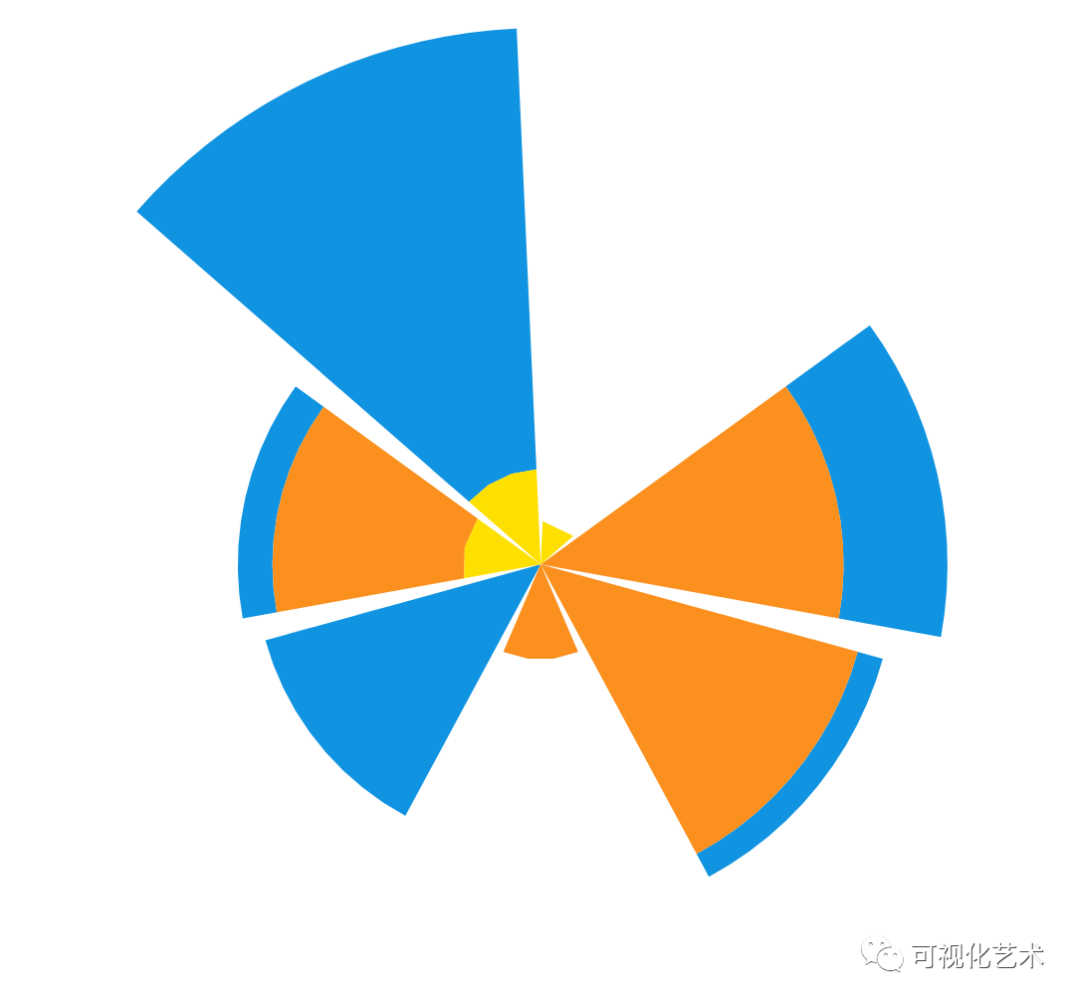
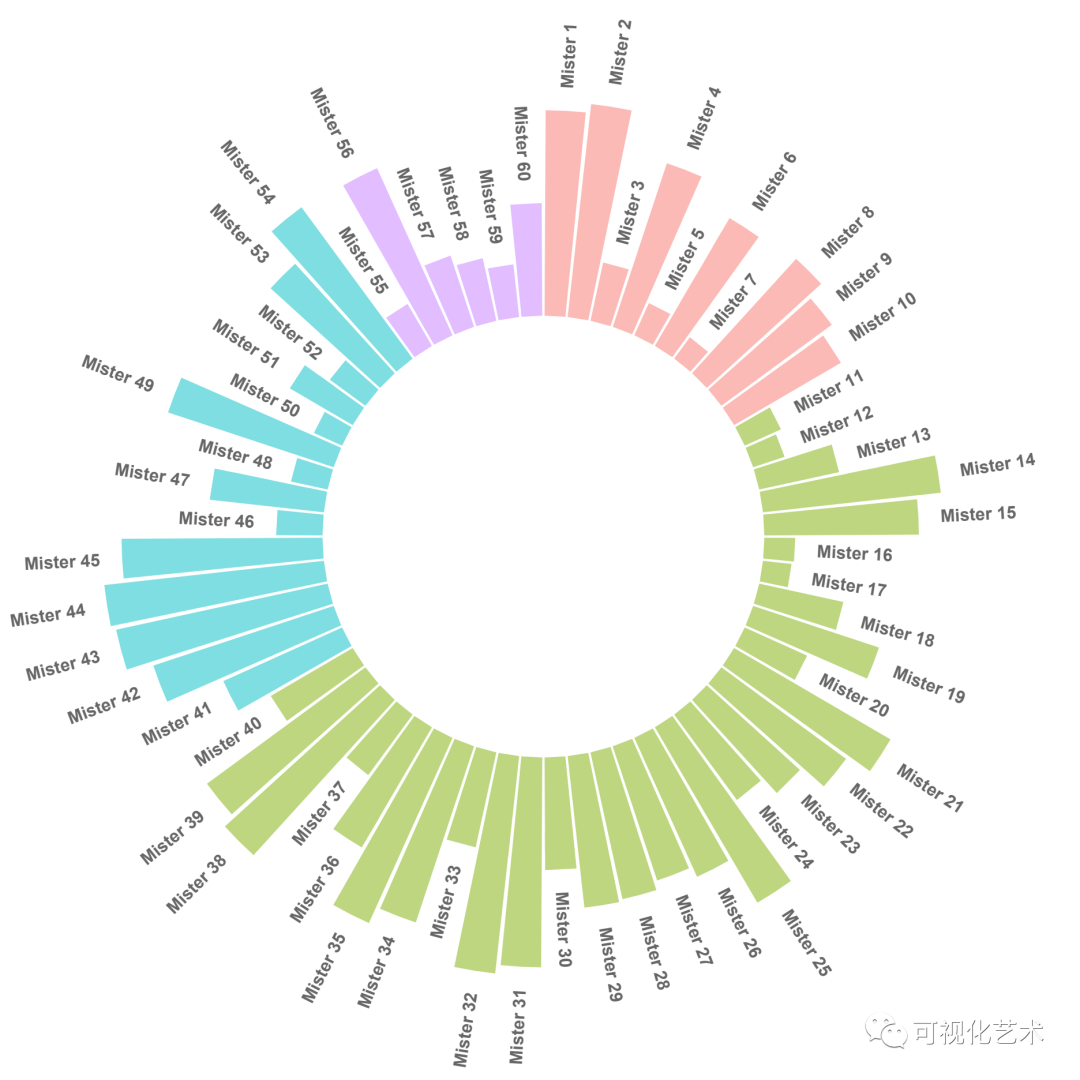

❝制作不易,欢迎「点赞+在看」!您的支持是师兄持续更新的动力!
❞
绘图代码
图1
# 载入R包:
library(ggplot2)
################################
# plot1:把y轴方向扭曲了,柱子都变成了弯的:加上颜色分组:
ggplot(mpg, aes(class))+
geom_bar(aes(fill=drv))+
coord_polar(theta = "y")
ggsave("plot1.pdf", height = 6, width = 6)
# plot1.1:修饰
ggplot(mpg, aes(class))+
geom_bar(aes(fill=drv))+
coord_polar(theta = "y")+
theme_bw()+
# 调整标签字体和位置:
geom_text(hjust = 1, size = 3,
aes(x = class, y = 0, label = class, fontface="italic")) +
# 设置主题:
theme_minimal() +
# 去掉x轴和y轴标题:
xlab("") +
ylab("") +
# 调整主题:
theme(legend.position = "none", # 去掉图例
panel.grid.major = element_blank(),
panel.grid.minor = element_blank(),
axis.text.y = element_blank(),
axis.text.x = element_text(color="black", face="italic"))+
# 设置y轴范围:
ylim(c(0,80))+
# 设置填充颜色:
scale_fill_manual(values = c("#1093e1","#fb901e","#fee000"))
ggsave("plot1.1.pdf", height = 6, width = 6)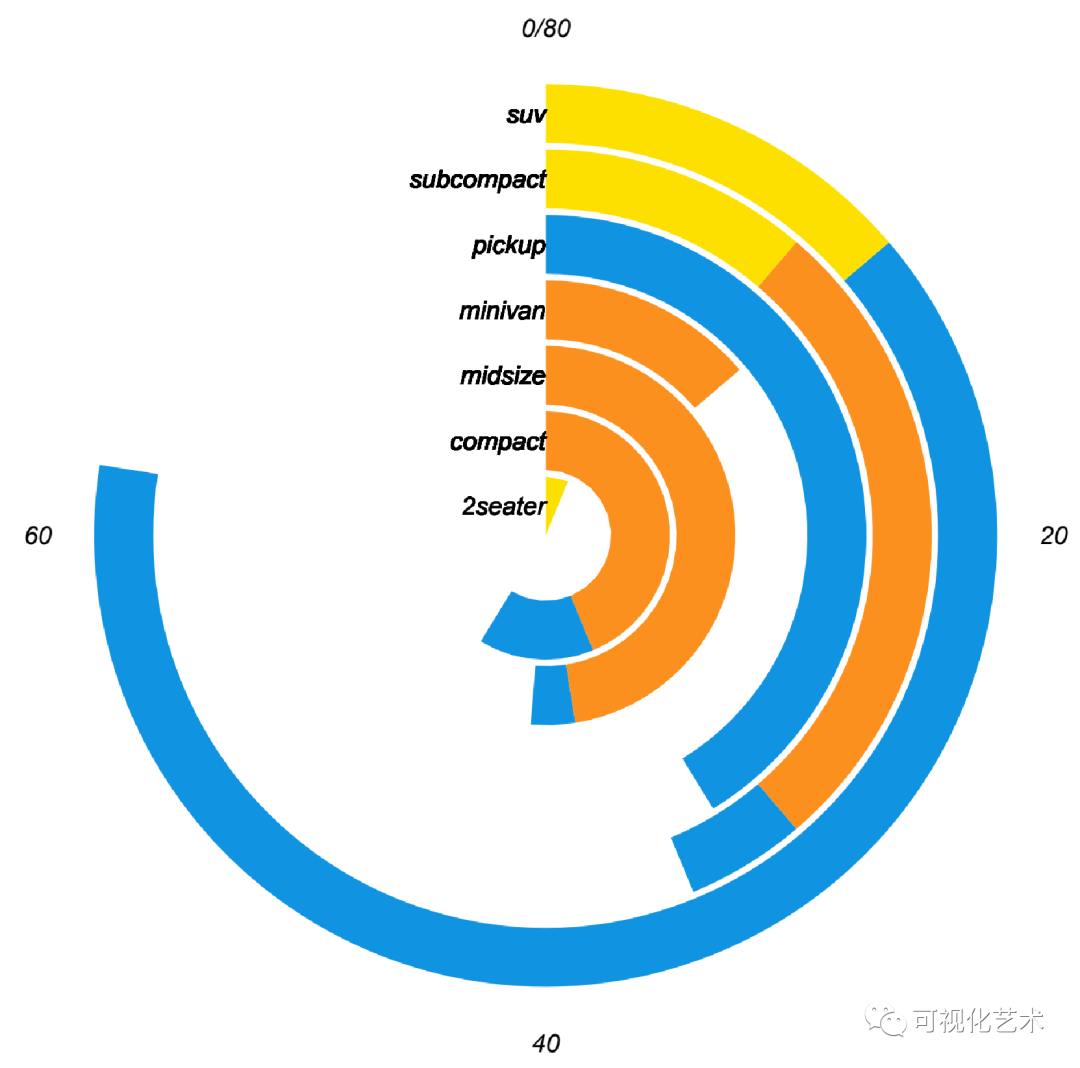
图2
################################
# plot2:把x轴方向扭曲了,柱子都从同一个中心出发,加上颜色分组:
ggplot(mpg, aes(class))+
geom_bar(aes(fill=drv))+
coord_polar(theta = "x")
ggsave("plot2.pdf", height = 6, width = 6)
# plot2.1:修饰
ggplot(mpg, aes(class))+
geom_bar(aes(fill=drv))+
coord_polar(theta = "x")+
theme_bw()+
# 设置主题:
theme_minimal() +
# 去掉x轴和y轴标题:
xlab("") +
ylab("") +
# 调整主题:
theme(legend.position = "none", # 去掉图例
panel.grid.major = element_blank(),
panel.grid.minor = element_blank(),
axis.text.y = element_blank(),
axis.text.x = element_text(color="black", face="bold.italic", size= 8))+
# 设置y轴范围:
ylim(c(0,80))+
# 设置填充颜色:
scale_fill_manual(values = c("#1093e1","#fb901e","#fee000"))
ggsave("plot2.1.pdf", height = 6, width = 6)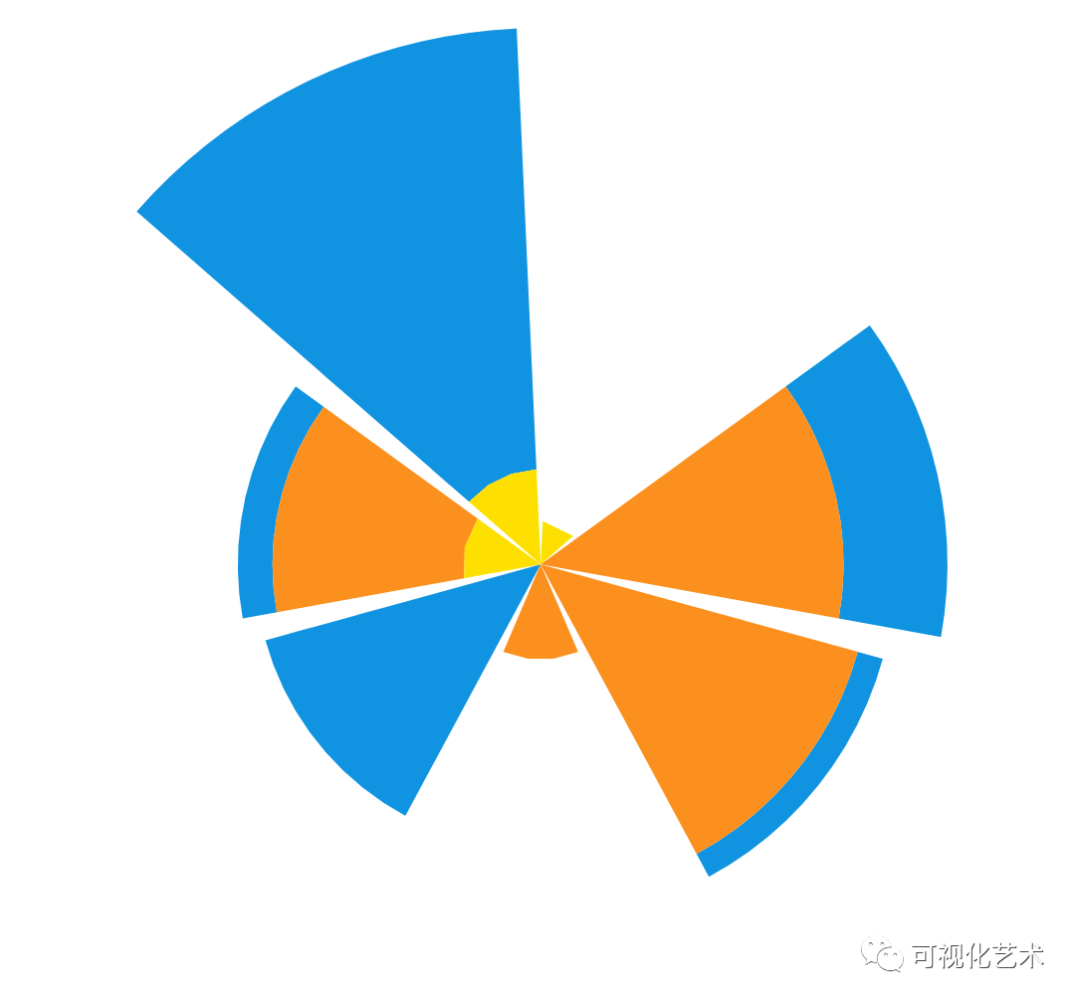
图3
####################### 分组环形柱状图 ##############################
library(tidyverse)
# 创建数据:
data <- data.frame(
individual=paste( "Mister ", seq(1,60), sep=""),
group=c( rep('A', 10), rep('B', 30), rep('C', 14), rep('D', 6)) ,
value=sample( seq(10,100), 60, replace=T)
)
# 设置一些“空栏”添加到每个组的末尾
empty_bar <- 4
to_add <- data.frame( matrix(NA, empty_bar*nlevels(data$group), ncol(data)) )
colnames(to_add) <- colnames(data)
to_add$group <- rep(levels(data$group), each=empty_bar)
data <- rbind(data, to_add)
data <- data %>% arrange(group)
data$id <- seq(1, nrow(data))
# 获取每个标签的名称和y位置
label_data <- data
number_of_bar <- nrow(label_data)
angle <- 90 - 360 * (label_data$id-0.5) /number_of_bar # I substract 0.5 because the letter must have the angle of the center of the bars. Not extreme right(1) or extreme left (0)
label_data$hjust <- ifelse( angle < -90, 1, 0)
label_data$angle <- ifelse(angle < -90, angle+180, angle)
# 绘图
ggplot(data, aes(x=as.factor(id), y=value, fill=group)) + # Note that id is a factor. If x is numeric, there is some space between the first bar
geom_bar(stat="identity", alpha=0.5) +
ylim(-100,120) +
theme_minimal() +
theme(
legend.position = "none",
axis.text = element_blank(),
axis.title = element_blank(),
panel.grid = element_blank(),
plot.margin = unit(rep(-1,4), "cm")
) +
coord_polar() +
geom_text(data=label_data, aes(x=id, y=value+10, label=individual, hjust=hjust), color="black", fontface="bold",alpha=0.6, size=2.5, angle= label_data$angle, inherit.aes = FALSE )
ggsave("plot3.1.pdf", height = 6, width = 6)
图4
################
# 加载包
library(ggplot2)
library(tidyverse)
# install.packages('ragg')
library(ragg)
# 创建一个数据
data <- data.frame(
individual=paste( "Mister ", seq(1,60), sep=""),
group=c( rep('A', 10), rep('B', 30), rep('C', 14), rep('D', 6)) ,
value=sample( seq(10,100), 60, replace=TRUE)
)
head(data)
# individual group value
#1 Mister 1 A 70
#2 Mister 2 A 79
#3 Mister 3 A 64
#4 Mister 4 A 92
#5 Mister 5 A 64
#6 Mister 6 A 83
# 对数据做转换
datagroup <- data$group %>% unique() #"A" "B" "C" "D"
allplotdata <- tibble('group' = datagroup,
'individual' = paste0('empty_individual_', seq_along(datagroup)),
'value' = 0) %>%
bind_rows(data) %>% arrange(group) %>% mutate(xid = 1:n()) %>%
mutate(angle = 90 - 360 * (xid - 0.5) / n()) %>%
mutate(hjust = ifelse(angle < -90, 1, 0)) %>%
mutate(angle = ifelse(angle < -90, angle+180, angle))
head(allplotdata)
# A tibble: 6 x 6
# group individual value xid angle hjust
# <chr> <chr> <dbl> <int> <dbl> <dbl>
#1 A empty_individual_1 0 1 87.2 0
#2 A Mister 1 70 2 81.6 0
#3 A Mister 2 79 3 75.9 0
#4 A Mister 3 64 4 70.3 0
#5 A Mister 4 92 5 64.7 0
#6 A Mister 5 64 6 59.1 0
# 提取出空的数据,做一些调整
firstxid <- which(str_detect(allplotdata$individual, pattern = "empty_individual")) # 1 12 43 58
segment_data <- data.frame('from' = firstxid + 1,
'to' = c(c(firstxid - 1)[-1], nrow(allplotdata)),
'label' = datagroup) %>%
mutate(labelx = as.integer((from + to)/2))
# from to label labelx
#1 2 11 A 6
#2 13 42 B 27
#3 44 57 C 50
#4 59 64 D 61
# 自定坐标轴
coordy <- tibble('coordylocation' = seq(from = min(allplotdata$value), to = max(allplotdata$value), 10),
'coordytext' = as.character(round(coordylocation, 2)),
'x' = 1)
# 自定义坐标轴的网格
griddata <- expand.grid('locationx' = firstxid[-1], 'locationy' = coordy$coordylocation)
# 绘图
ggplot() +
geom_bar(data = allplotdata, aes(x = xid, y = value, fill = group), stat = 'identity') +
geom_text(data = allplotdata %>% filter(!str_detect(individual, pattern = "empty_individual")),
aes(x = xid, label = individual, y = value+10, angle = angle, hjust = hjust),
color="black", fontface="bold",alpha=0.6, size=2.5) +
geom_segment(data = segment_data, aes(x = from, xend = to), y = -5, yend=-5) +
geom_text(data = segment_data, aes(x = labelx, label = label), y = -15) +
geom_text(data = coordy, aes(x = x, y = coordylocation, label = coordytext),
color="grey", size=3 , angle=0, fontface="bold") +
geom_segment(data = griddata,
aes(x = locationx-0.5, xend = locationx + 0.5, y = locationy, yend = locationy),
colour = "grey", alpha=0.8, size=0.6) +
scale_x_continuous(expand = c(0, 0)) +
scale_y_continuous(limits = c(-50,100)) +
coord_polar() +
theme_void() +
theme(legend.position = 'none')
# 保存
ggsave('plot3.2.pdf',width = 6, height = 6, device = ragg::agg_png())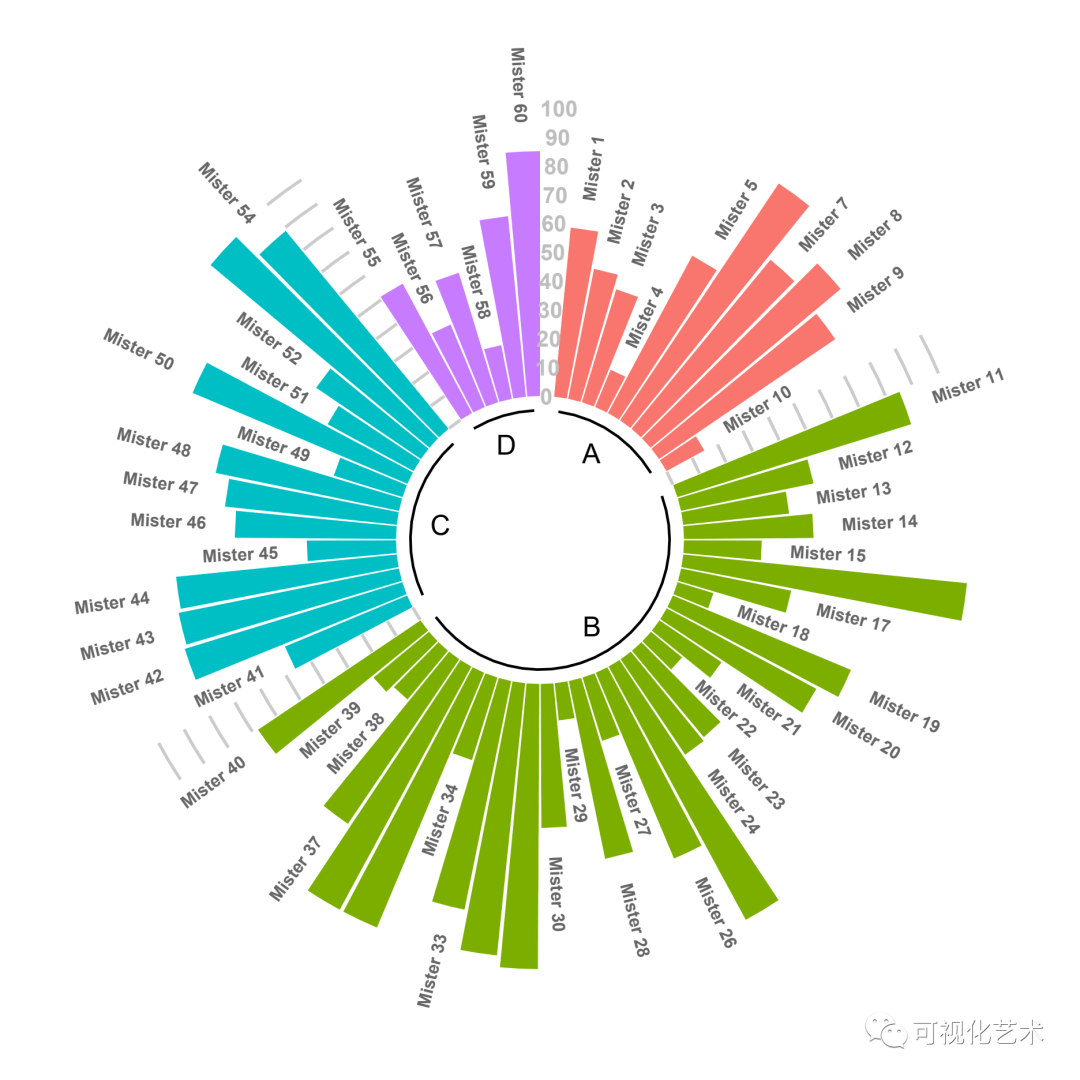
❝本期「代码+示例数据+效果图+课程笔记」,均可在公众号「可视化艺术」后台回复「20220228」获得!
❞